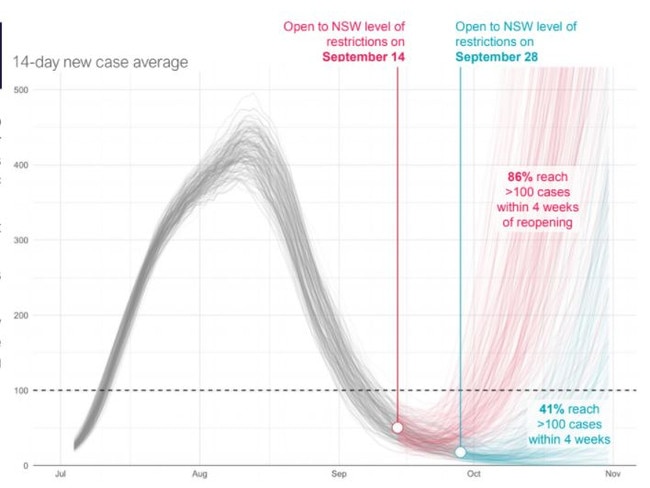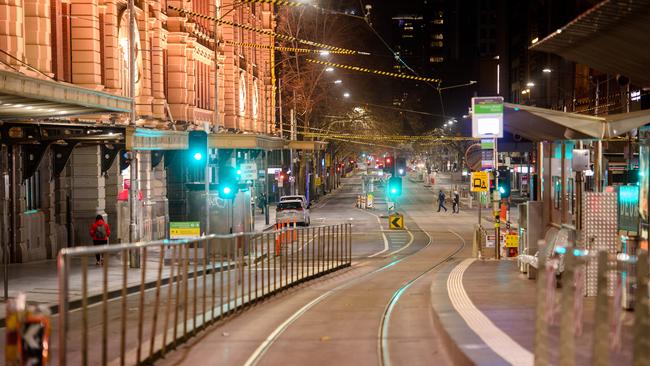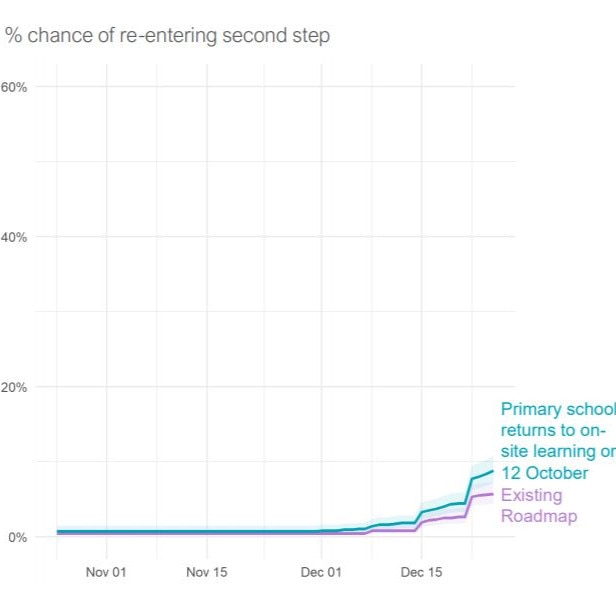Modelling shows Melbourne is ahead of projections for suppressing COVID-19
These are the all-important figures that helped bring forward Melbourne’s next step out of lockdown. But another key piece of modelling has shown the dire consequences if restrictions were lifted right now.

HS Coronavirus News
Don't miss out on the headlines from HS Coronavirus News. Followed categories will be added to My News.
New modelling released by the Department of Health and Human Services reveals Melbourne is ahead of projections for suppressing COVID-19, placing the city on track to end lockdown by October 19.
The latest report released by DHHS shows its internal calculations placed Melbourne’s Reff number at 0.69 last week, while Doherty Institute modelling placed the Reff at 0.75.
Both are ahead of schedule and great news for Melburnians, meaning restrictions can ease a week earlier than foreshadowed.
The all-important Reff number is the rate at which coronavirus is considered to be spreading, and any number below one signals the virus retreating.

However, further modelling by Melbourne’s Burnett Institute shows easing restrictions immediately would come with potentially dire consequences.
The Burnett Institute modelling reveals an opening of bars, clubs, workplaces and public gatherings on Sunday would come with a 41 per cent chance of a third coronavirus wave sweeping through Melbourne within four weeks.
“Reopening too soon risks wasting all the sacrifices Victorians have made over the last few months,” the modelling report released by DHHS says.

The move to allow all primary school students to return to face-to-face learning was based on research and modelling compiled by the Murdoch Children’s Research Institute, reinforcing international evidence that schools seldom drive outbreaks.
The MCRI analysis of Victorian infection data revealed that even when young children were infected in the wider community before attending school, their attendance rarely resulted in a further school-based outbreak.

Previous modelling had calculated that children under 10 were 71 per cent as infective as adults; however, the new MCRI research places their infectivity at 51 per cent — meaning they have only half the chances of passing the virus on as an adult.

A DHHS brief of the research states the greatest risk of spreading COVID-19 through schools comes from adults during pick-up and drop-off times, rather than students mixing in classrooms.
“There is growing evidence that the risk of large outbreaks of SARS-CoV-2 within the school setting is low when there are low levels of the virus spreading around the community,” DHHS modelling report states.
“While very few significant outbreaks occur in schools, they do occur, and this has often been associated with high rates of community transmission and lack of adherence to social distancing in the school setting.
“The (MCRI) report shows that the risk of COVID-19 school transmission is low when case numbers are low like in Victoria today.
“Children less than 10 years old seem to transmit coronavirus less than adolescents and adults.”
Murdoch Children’s Research Institute has presented research to the department using Victorian data.
Where young children have been infected and gone to school in Victoria, outbreaks have been very uncommon. Murdoch Children's Research Institute’s research confirms internal research by the department that schools are more likely to act as a multiplier of existing community transmission rather than a driver of the epidemic.
The risks primarily relate to household transmission and increased movement, including by adults during pick up and drop off.
The University of Melbourne model captures the impact of this movement.
MORE NEWS
MELBOURNE CURFEW TO END, THIRD STEP BROUGHT FORWARD
WHAT YOU CAN AND CAN’T DO UNDER STEP TWO
